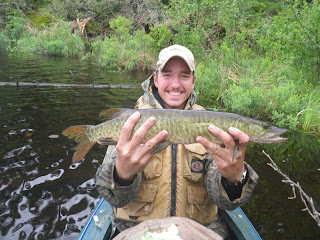The 2013 fishing season has been excellent so it was a fitting end to see a very unique catch during this last week. Tom landed a 31″ Tiger Muskie on Red Lake. This is only the second Tiger Muskie we have seen this season.
Tom was by himself when he landed the Tiger Muskie so here’s a shot of the angler that caught and released the elusive fish.
Here is a photo of the first Tiger Muskie this season. My brother Carson landed a massive 41.5″ fish with a growth on top of its head.
A Tiger Muskie is a cross between a Northern Pike and a Muskie. Pike usually spawn first, but once in a great while a Pike will spawn late enough to match the Muskie spawn and presto – the Tiger Muskie. Tigers grow faster than either pure strain parent and are usually infertile – part of what makes them so rare. The dark bars on the light background can look similar to a pure “barred” Muskie, but the giveaway is the more rounded tail lobes (same as a Northern Pike) which are unique to the Tiger Muskie. A barred Muskie has sharper pointed tail lobes.
Need help identifying your catch? Most fish caught are Northern Pike. I know you didn’t forget what a Pike looked like, but here’s a refresher – Tom’s 43.5″ Northern off Red Lake. See the light spots on a dark background and rounded tail lobes.
Muskies are rare, but we do see a few each season. Pike spawn earlier than Muskies do and young pike will prey on the baby Muskies which is one limiting factor to the muskie population. There are three distinct patterns of pure Muskies (clear, spotted, and barred) and the cross between Pike and Muskie (Tiger Muskie). Most Muskies caught here are the clear variety. A common factor in all Muskies is dark markings or no markings on a light background which is the opposite of Pike.
See Mike’s 41.5″ clear Muskie caught earlier this year as an example.
Below is a barred Muskie that Carson caught last year. It is similar to the Tiger Muskie, but note the pointed tail lobes.
Cosmo wants to remind everyone that he is a “Tiger Lab” since he has a rounded tail lobe as well.
A rare breed puppy for sure!
Another way to identify Muskies vs. Pike is to count the pores on the underside of the jaw. A Pike will have five or fewer on each side while a Muskie will have six to nine pores on each side of the jaw. You can’t use this to distinguish a Tiger Muskie though since they can inherit the pore count from either parent.
As a side note, Tom’s Tiger Muskie pushed us to a new season high for muskies caught and released – nine! Carrie and I have a few more days left to see if we can make it double digits!

